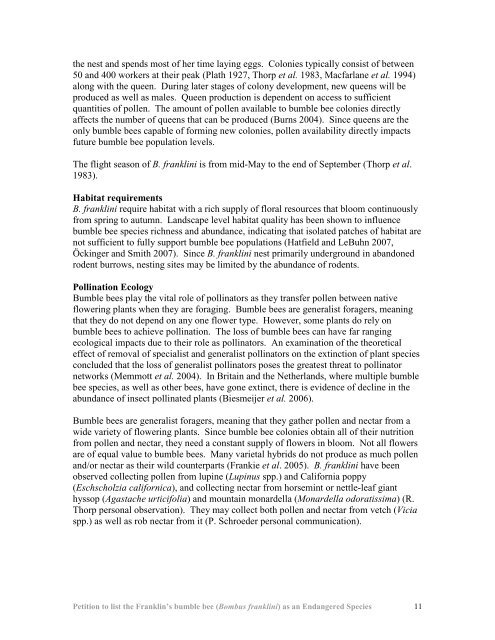Franklin's bumble bee - The Xerces Society
Franklin's bumble bee - The Xerces Society
Franklin's bumble bee - The Xerces Society
You also want an ePaper? Increase the reach of your titles
YUMPU automatically turns print PDFs into web optimized ePapers that Google loves.
the nest and spends most of her time laying eggs. Colonies typically consist of between<br />
50 and 400 workers at their peak (Plath 1927, Thorp et al. 1983, Macfarlane et al. 1994)<br />
along with the queen. During later stages of colony development, new queens will be<br />
produced as well as males. Queen production is dependent on access to sufficient<br />
quantities of pollen. <strong>The</strong> amount of pollen available to <strong>bumble</strong> <strong>bee</strong> colonies directly<br />
affects the number of queens that can be produced (Burns 2004). Since queens are the<br />
only <strong>bumble</strong> <strong>bee</strong>s capable of forming new colonies, pollen availability directly impacts<br />
future <strong>bumble</strong> <strong>bee</strong> population levels.<br />
<strong>The</strong> flight season of B. franklini is from mid-May to the end of September (Thorp et al.<br />
1983).<br />
Habitat requirements<br />
B. franklini require habitat with a rich supply of floral resources that bloom continuously<br />
from spring to autumn. Landscape level habitat quality has <strong>bee</strong>n shown to influence<br />
<strong>bumble</strong> <strong>bee</strong> species richness and abundance, indicating that isolated patches of habitat are<br />
not sufficient to fully support <strong>bumble</strong> <strong>bee</strong> populations (Hatfield and LeBuhn 2007,<br />
Öckinger and Smith 2007). Since B. franklini nest primarily underground in abandoned<br />
rodent burrows, nesting sites may be limited by the abundance of rodents.<br />
Pollination Ecology<br />
Bumble <strong>bee</strong>s play the vital role of pollinators as they transfer pollen between native<br />
flowering plants when they are foraging. Bumble <strong>bee</strong>s are generalist foragers, meaning<br />
that they do not depend on any one flower type. However, some plants do rely on<br />
<strong>bumble</strong> <strong>bee</strong>s to achieve pollination. <strong>The</strong> loss of <strong>bumble</strong> <strong>bee</strong>s can have far ranging<br />
ecological impacts due to their role as pollinators. An examination of the theoretical<br />
effect of removal of specialist and generalist pollinators on the extinction of plant species<br />
concluded that the loss of generalist pollinators poses the greatest threat to pollinator<br />
networks (Memmott et al. 2004). In Britain and the Netherlands, where multiple <strong>bumble</strong><br />
<strong>bee</strong> species, as well as other <strong>bee</strong>s, have gone extinct, there is evidence of decline in the<br />
abundance of insect pollinated plants (Biesmeijer et al. 2006).<br />
Bumble <strong>bee</strong>s are generalist foragers, meaning that they gather pollen and nectar from a<br />
wide variety of flowering plants. Since <strong>bumble</strong> <strong>bee</strong> colonies obtain all of their nutrition<br />
from pollen and nectar, they need a constant supply of flowers in bloom. Not all flowers<br />
are of equal value to <strong>bumble</strong> <strong>bee</strong>s. Many varietal hybrids do not produce as much pollen<br />
and/or nectar as their wild counterparts (Frankie et al. 2005). B. franklini have <strong>bee</strong>n<br />
observed collecting pollen from lupine (Lupinus spp.) and California poppy<br />
(Eschscholzia californica), and collecting nectar from horsemint or nettle-leaf giant<br />
hyssop (Agastache urticifolia) and mountain monardella (Monardella odoratissima) (R.<br />
Thorp personal observation). <strong>The</strong>y may collect both pollen and nectar from vetch (Vicia<br />
spp.) as well as rob nectar from it (P. Schroeder personal communication).<br />
Petition to list the Franklin’s <strong>bumble</strong> <strong>bee</strong> (Bombus franklini) as an Endangered Species 11
















